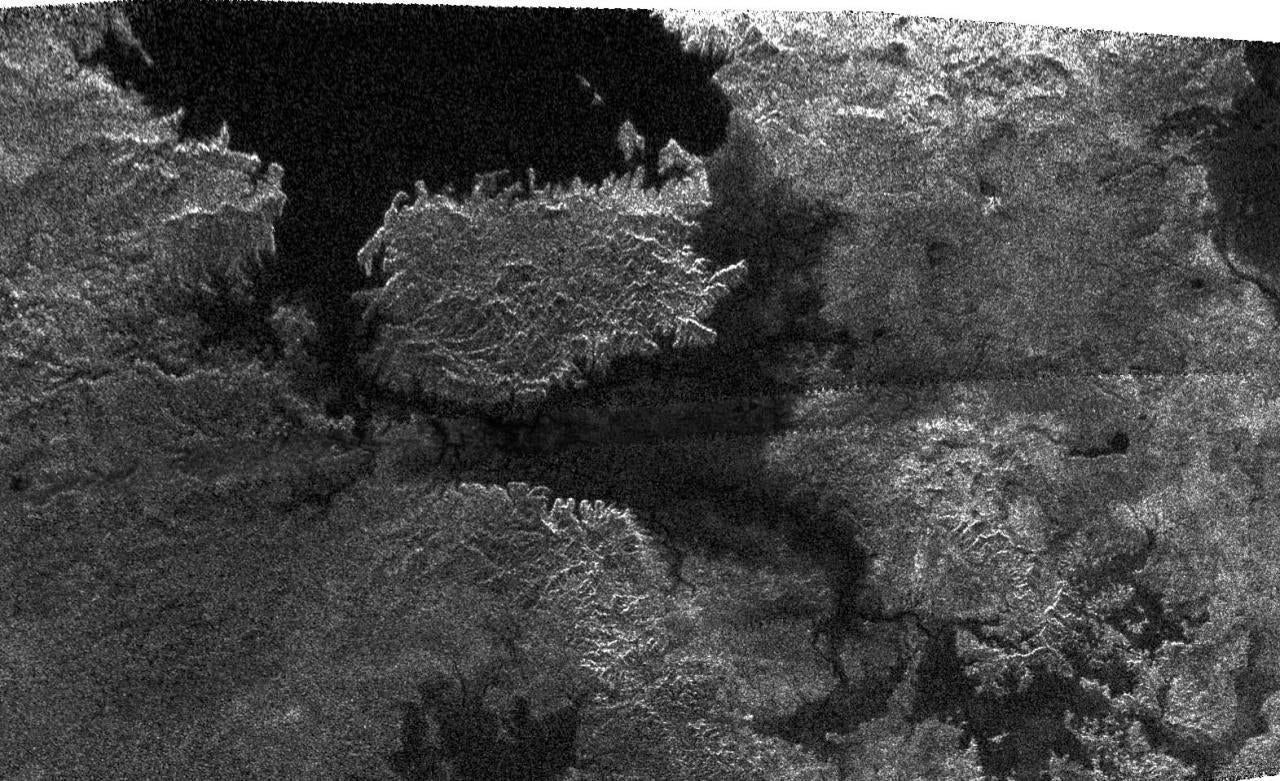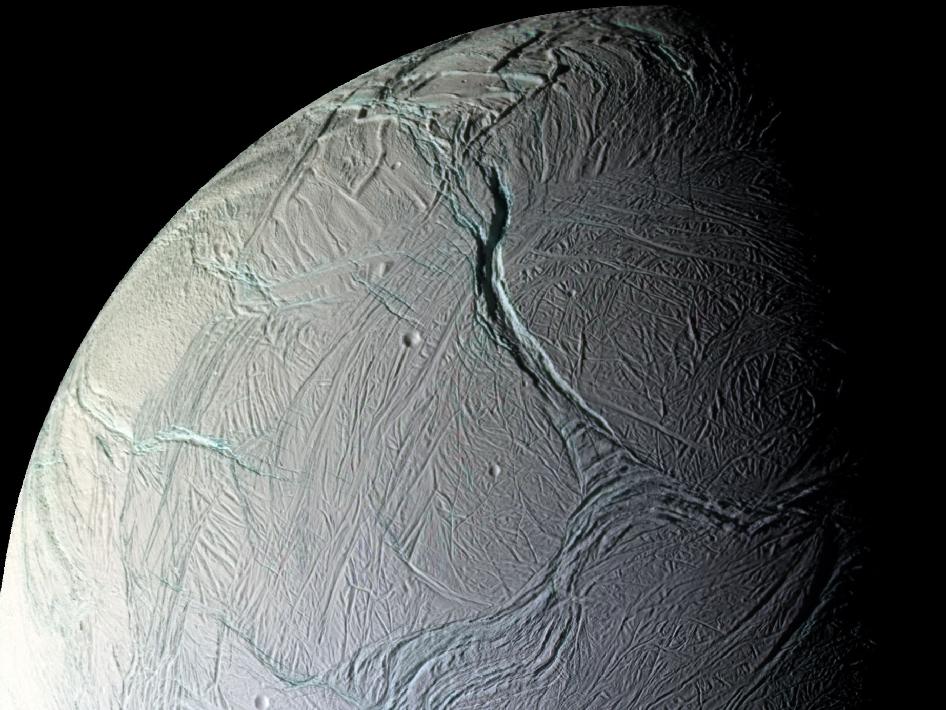No swimming in this Great Lake
Question: What other solar system body has lakes? Answer: Titan, the largest moon of Saturn (slightly bigger than our moon and Mercury). The biggest lake is the size of Caspian Sea and Lake Superior combined. Methane and ethane, gases on Earth, are cold enough to be liquid on Titan. Night sky highlights this week: Wednesday evening 45 minutes after sunset, see Venus and a thin crescent moon in the southwest sky. Venus bright but alone in the southwest after sunset. Jupiter rising in the east at 11 p.m. And in defending the wisdom of yesterday’s time change… yes, the sun sets earlier and earlier, but we need endure the trend for less than two additional months.
November 4, 2013
[Dave Heller] While the search continues for water on Mars and even the moon, there’s another member of our solar system with lakes — GREAT lakes. Let’s dive in with Derrick Pitts, chief astronomer at the Franklin Institute. Derrick, wet suit required, or bathing trunks sufficient?
[Derrick Pitts] Oh, I definitely think a wet suit is required, and you’re going to need long underwear where we’re going for this discovery of lakes.
Where are we going?
It’s out at the planet Saturn, the largest moon of Saturn called Titan, turns out to now have what we see as lakes of liquid on its surface. Now the real catch is that the temperature out at that location is about 230 degrees below zero Farenheit.
That’s a big clue that we’re not talkin’ about water.
You’re exactly right. It certainly would be frozen if we were talking about water. What we’re talking about are the liquified gasses methane and ethane. So in the Titan atmosphere, there’s plenty of methane in the atmosphere; that’s been discovered some years ago. And we knew that there was some evidence when we looked at the surface with a lander that dropped down onto the surface a few years ago that there looked like there were stream beds and maybe even, possibly, small puddles of methane on the surface. But now the Cassini spacecraft has been able to identify on the surface lakes near the north pole of the planet, and some of them quite large lakes, of liquid methane and liquid ethane.
-

This radar image, obtained by Cassini’s radar instrument during a near-polar flyby on Feb. 22, 2007, shows a big island smack in the middle of one of the larger lakes imaged on Saturn’s moon Titan. This image offers further evidence that the largest lakes are at the highest latitudes. Photo credit: NASA
Is it a stretch to call them Great Lake size?
It’s not a stretch at all. The largest one of these lakes is the size of Lake Superior and the Caspian Sea combined — that’s an enormous size! There are others that are 250 miles across, so they really are very, very big.
And does that methane and ethane float back up and come down as rain?
The really cool thing about what goes on here is it seems as if there’s some sort of — dare I use the word? — hydrologic cycle, where the liquid evaporates, goes up into the atmosphere, condenses and then comes back down somehow. Because we can see that there are stream beds, so it means that the liquid is flowing on the surface. There are pools of it we now identify as lakes, and so it has to get back up to the atmosphere somehow, so you might say that it does rain methane and ethane on the planet. And I think probably the most curious thing about these lakes on Titan is the idea that when they evaporate, they leave deposits of organic molecules. Now indeed the surface is very cold and the atmosphere is completely inhospitable, but just the same, it at least shows us that there’s a possibility for organic molecules to exist in other places besides this planet. So when we look at places like Enceladus, where there is a liquid water ocean beneath an icy crust, it can lead one to believe that perhaps there’s some more advanced development of these organic molecules into more complex chemical compounds.
“When we look at places like Enceladus, where there is a liquid water ocean beneath an icy crust, it can lead one to believe that perhaps there’s some more advanced development of these organic molecules into more complex chemical compounds.”
Derrick Pitts
-

Enceladus. Photo credit: NASA
Of course Titan’s too tiny to see with the naked eye. What is visible in the night sky this week?
Plenty of great stuff visible in the evening sky. About 40 minutes after sunset we can see Venus over on the western horizon. But on Wednesday evening, we’ll see it below a very thin crescent moon, so that should be a beautiful sight. If you’d like to see one of the gas giants of the solar system, at about 11 p.m. Jupiter is rising in the eastern horizon; maybe not high enough for a great view, but certainly by the next morning, about half an hour to 45 minutes before sunrise, we’ll be able to see Jupiter high in the south. Of course this is a great time to be able to see objects in the predawn sky because sunrise is coming so late these days.
Speaking of which, Derrick, a lot more of our listeners are driving home in the dark this evening. I guess they were denied a vote in turning back the clocks?
[Laughs] And maybe it’s a good thing that someone else took the reins on this some time ago, because here’s what happens if we were to stay on Eastern Standard Time all year round: The earliest sunrise would come at 4:31 in the morning. Not very useful in the sense that the sun is up long before most of us are really headed out to work. Yes, some are very early risers, but we have a lot of sunlight in the portion of the day that’s not being used by most people in our society these days. Likewise, sunset would come at 7:32 in the evening in the summer. Now because it’s so warm, wouldn’t it be better to have that extra light at the backend of the day when we’re still active, rather than early in the morning when most of us are still asleep? If we were to stay on Eastern Daylight Time, instead of changing like we did yesterday, the latest sunrise would come at 8:22 in the morning! Now most of us are certainly up by 6, 6:30, 7; we’re getting off to work early in the morning, getting kids off to school as early as 7:00 in the morning. That means that it’d still be dark for an hour and a half before they even get to school. So we don’t have sunlight during the time of day when we can best use it. On the other end of the day, sun is setting at 4:32 in the evening; well, it doesn’t really matter because evening is coming anyway. And the other thing is that in the evening we find that at this time of year we start to add more minutes of time to the day anyway in mid-December because sunsets start to come later and later very early in the winter season.
Ah, that’s the best part of the explanation that soon the days will start to grow longer again.
And at least it’ll feel like it because the latest sunrise doesn’t really come until early January. And we see the coming added time at sunset when we can actually really feel it.
-

Photo by Flickr user Kevin Harber
WHYY is your source for fact-based, in-depth journalism and information. As a nonprofit organization, we rely on financial support from readers like you. Please give today.




